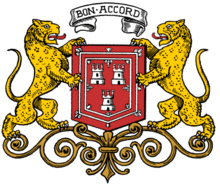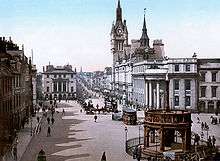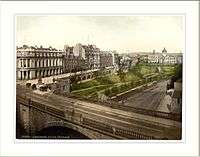Aberdeen
Aberdeen (/ˌæbərˈdiːn/ (![]()
![]()
Aberdeen
| |
|---|---|
City and council area | |
 From left to right: Marischal College, West Tower of the new Town House on Union Street, River Dee view from Tollohill Woods, Old Aberdeen High Street, Aberdeen Beach | |
 Flag | |
| Nicknames: "Granite City", "Grey City", "Silver City", and "Silver City with the Golden Sands" | |
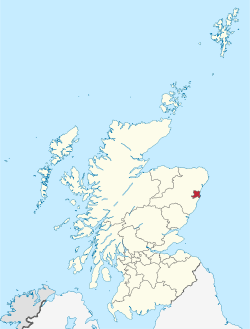 Location within Scotland | |
| Coordinates: 57.15°N 2.11°W | |
| Sovereign state | United Kingdom |
| Country | Scotland |
| Council area | Aberdeen City |
| Lieutenancy area | Aberdeen |
| Earliest Charter | 1179 |
| City status | 1891 |
| Government | |
| • Governing body | Aberdeen City Council |
| • Lord Provost | Barney Crockett |
| • MSPs |
|
| • MPs |
|
| Area | |
| • City and council area | 71.7 sq mi (185.7 km2) |
| Population (mid-2019 est.) | 196,670[1] |
| • Density | 9,080/sq mi (3,505.7/km2) |
| • Urban | 214,610[2] |
| • Metro | 239,530[3] |
| • Language(s) | Scots (Doric), English |
| Demonym(s) | Aberdonians |
| Time zone | UTC±0 (GMT) |
| • Summer (DST) | UTC+1 (BST) |
| Postcode areas | |
| Area code(s) | 01224 |
| ISO 3166-2 | GB-ABE |
| ONS code | S12000033 |
| OS grid reference | NJ925065 |
| NUTS 3 | UKM50 |
| Primary Airport | Aberdeen Airport |
| Website | www |
During the mid-18th to mid-20th centuries, Aberdeen's buildings incorporated locally quarried grey granite, which can sparkle like silver because of its high mica content.[7] Since the discovery of North Sea oil in the 1970s, Aberdeen has been known as the off-shore oil capital of Europe.[8] The area around Aberdeen has been settled for at least 8,000 years,[9] when prehistoric villages lay around the mouths of the rivers Dee and Don. The city has a long, sandy coastline and a marine climate, the latter resulting in chilly summers and mild winters.
Aberdeen received Royal burgh status from David I of Scotland (1124–1153),[10] transforming the city economically. The city has two universities, the University of Aberdeen, founded in 1495, and Robert Gordon University, which was awarded university status in 1992, making Aberdeen the educational centre of north-east Scotland. The traditional industries of fishing, paper-making, shipbuilding, and textiles have been overtaken by the oil industry and Aberdeen's seaport. Aberdeen Heliport is one of the busiest commercial heliports in the world[11] and the seaport is the largest in the north-east of Scotland.[12]
Aberdeen used to host the Aberdeen International Youth Festival, a major international event which attracted up to 1000 of the most talented young performing arts companies but the council ended funding in 2017 and the festival was wound up in 2018. In 2015, Mercer named Aberdeen the 57th most liveable city in the world, as well as the fourth most liveable city in Britain.[13] In 2012, HSBC named Aberdeen as a leading business hub and one of eight 'super cities' spearheading the UK's economy, marking it as the only city in Scotland to receive this accolade.[14] In 2018, Aberdeen was found to be the best city in the UK to start a business in a study released by card payment firm Paymentsense.[15]
History

The Aberdeen area has seen human settlement for at least 8,000 years.[9] The city began as two separate burghs: Old Aberdeen at the mouth of the river Don; and New Aberdeen, a fishing and trading settlement, where the Denburn waterway entered the river Dee estuary.[16] The earliest charter was granted by William the Lion in 1179 and confirmed the corporate rights granted by David I.
In 1319, the Great Charter of Robert the Bruce transformed Aberdeen into a property-owning and financially independent community. Granted with it was the nearby Forest of Stocket, whose income formed the basis for the city's Common Good Fund which still benefits Aberdonians.[17][18]
During the Wars of Scottish Independence, Aberdeen was under English rule, so Robert the Bruce laid siege to Aberdeen Castle before destroying it in 1308, followed by executing the English garrison. The city was burned by Edward III of England in 1336, but was rebuilt and extended. The city was strongly fortified to prevent attacks by neighbouring lords, but the gates were removed by 1770.
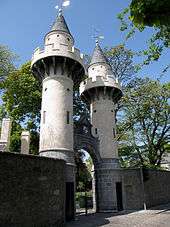
During the Wars of the Three Kingdoms of 1644 to 1647 the city was plundered by both sides. In 1644, it was taken and ransacked by Royalist troops after the Battle of Aberdeen[19] and two years later it was stormed by a Royalist force under the command of the Marquis of Huntly.[20] In 1647 an outbreak of bubonic plague killed a quarter of the population. In the 18th century, a new Town Hall was built and the first social services appeared with the Infirmary at Woolmanhill in 1742 and the Lunatic Asylum in 1779. The council began major road improvements at the end of the 18th century with the main thoroughfares of George Street, King Street and Union Street all completed at the beginning of the 19th century.
The expensive infrastructure works led to the city becoming bankrupt in 1817 during the Post-Napoleonic depression, an economic downturn immediately after the Napoleonic Wars; but the city's prosperity later recovered. The increasing economic importance of Aberdeen and the development of the shipbuilding and fishing industries led to the construction of the present harbour including Victoria Dock and the South Breakwater, and the extension of the North Pier. Gas street lighting arrived in 1824 and an enhanced water supply appeared in 1830 when water was pumped from the Dee to a reservoir in Union Place. An underground sewer system replaced open sewers in 1865.[18] The city was incorporated in 1891. Although Old Aberdeen has a separate history and still holds its ancient charter, it is no longer officially independent. It is an integral part of the city, as is Woodside and the Royal Burgh of Torry to the south of the River Dee.
Over the course of the Second World War Aberdeen was attacked 32 times by the German Luftwaffe. One of the most devastating attacks was on Wednesday 21 April 1943 when 29 Luftwaffe Dornier 217s flying from Stavanger, Norway attacked the city between the hours of 22:17 and 23:04.[21] A total of 98 civilians and 27 servicemen were killed, along with 9,668 houses damaged, after a mixture of 127 Incendiary, High Explosive and Cluster bombs were dropped on the city in one night. It was also the last German raid on a Scottish city during the war.
Toponymy
Aberdeen was in Pictish territory and became Gaelic-speaking at some time in the medieval period. Old Aberdeen is the approximate location of Aberdon, the first settlement of Aberdeen; this literally means "the mouth of the Don". The Celtic word aber means "river mouth", as in modern Welsh (Aberystwyth, Aberdare, Aberbeeg etc.).[22] The Scottish Gaelic name is Obar Dheathain (variation: Obairreadhain; *obar presumably being a loan from the earlier Pictish; the Gaelic term is inbhir), and in Latin, the Romans referred to the river as Devana. Mediaeval (or Ecclesiastical) Latin has it as Aberdonia.
Governance
Aberdeen is locally governed by Aberdeen City Council, which comprises forty-five councillors who represent the city's wards and is headed by the Lord Provost. The current Lord Provost is Barney Crockett.[23] From May 2003 until May 2007 the council was run by a Liberal Democrat and Conservative Party coalition. Following the May 2007 local elections, the Liberal Democrats formed a new coalition with the Scottish National Party.[24][25] After a later SNP by-election gain from the Conservatives, this coalition held 28 of the 43 seats. Following the election of 4 May 2017, the council was controlled by a coalition of Scottish Labour, Scottish Conservatives and independent councillors; the Labour councillors were subsequently suspended by Scottish Labour Party leader, Kezia Dugdale.[26]
Aberdeen is represented in the Parliament of the United Kingdom by three constituencies: Aberdeen North and Aberdeen South which are wholly within the Aberdeen City council area, and Gordon, which includes a large area of the Aberdeenshire Council area.
In the Scottish Parliament, the city is represented by three constituencies with different boundaries: Aberdeen Central and Aberdeen Donside are wholly within the Aberdeen City council area. Aberdeen South and North Kincardine includes the North Kincardine ward of Aberdeenshire Council. A further seven MSPs are elected as part of the North East Scotland electoral region. In the European Parliament the city was represented by six MEPs as part of the all-inclusive Scotland constituency.
Heraldry

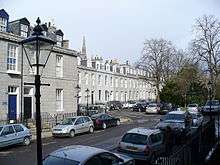
The arms and banner of the city show three silver towers on red. This motif dates from at least the time of Robert the Bruce and represents the buildings that stood on the three hills of medieval Aberdeen: Aberdeen Castle on Castle Hill (today's Castlegate); the city gate on Port Hill; and a church on St Catherine's Hill (now levelled).[27]
Bon Accord is the motto of the city and is French for "Good Agreement". Legend tells that its use dates from a password used by Robert the Bruce during the 14th-century Wars of Scottish Independence, when he and his men laid siege to the English-held Aberdeen Castle before destroying it in 1308.[17] It is still widely present in the city, throughout street names, business names and the city's Bon Accord shopping mall.[28]
The shield in the coat of arms is supported by two leopards. A local magazine is called the "Leopard" and, when Union Bridge was widened in the 20th century, small statues of the creature in a sitting position were cast and placed on top of the railing posts (known locally as Kelly's Cats). The city's toast is "Happy to meet, sorry to part, happy to meet again"; this has been commonly misinterpreted as the translation of Bon Accord.[29]
Geography
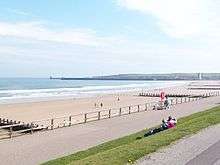
Being sited between two river mouths, the city has little natural exposure of bedrock. This leaves local geologists in a slight quandary: despite the high concentration of geoscientists in the area (courtesy of the oil industry), there is only a vague understanding of what underlies the city. To the south side of the city, coastal cliffs expose high-grade metamorphic rocks of the Grampian Group; to the southwest and west are extensive granites intruded into similar high-grade schists; to the north the metamorphics are intruded by gabbroic complexes instead.
The small amount of geophysics done, and occasional building-related exposures, combined with small exposures in the banks of the River Don, suggest that it is actually sited on an inlier of Devonian "Old Red" sandstones and silts. The outskirts of the city spread beyond the (inferred) limits of the outlier onto the surrounding metamorphic/ igneous complexes formed during the Dalradian period (approximately 480–600 million years ago) with sporadic areas of igneous Diorite granites to be found, such as that at the Rubislaw quarry which was used to build much of the Victorian parts of the city.[30]
On the coast, Aberdeen has a long sand beach between the two rivers, the Dee and the Don, which turns into high sand dunes north of the Don stretching as far as Fraserburgh; to the south of the Dee are steep rocky cliff faces with only minor pebble and shingle beaches in deep inlets. A number of granite outcrops along the south coast have been quarried in the past, making for spectacular scenery and good rock-climbing.
The city extends to 185.7 km2 (71.7 sq mi),[31] and includes the former burghs of Old Aberdeen, New Aberdeen, Woodside and the Royal Burgh of Torry to the south of River Dee. In 2017 this gave the city a population density of 1,225.[6] The city is built on many hills, with the original beginnings of the city growing from Castle Hill, St. Catherine's Hill and Windmill Hill.[32]
Climate
Aberdeen features an oceanic climate (Köppen Cfb). Aberdeen has far milder winter temperatures than one might expect for its northern location, although statistically it is the coldest city in the UK. During the winter, especially throughout December, the length of the day is very short, averaging 6 hours and 41 minutes between sunrise and sunset at winter solstice.[33] As winter progresses, the length of the day grows fairly quickly, to 8 hours and 20 minutes by the end of January. Around summer solstice, the days will be around 18 hours long, having 17 hours and 55 minutes between sunrise and sunset.[33] During this time of the year marginal nautical twilight lasts the entire night. Temperatures at this time of year hover around 17.0 °C (62.6 °F) during the day in most of the urban area, though nearer 16.0 °C (60.8 °F) directly on the coast, and around 18.0 to 19.0 °C (64.4 to 66.2 °F) in the westernmost suburbs,[34] illustrating the cooling effect of the North Sea during summer. In addition, from June onward skies are more overcast than in April/May, as reflected in a lower percentage of possible sunshine (the percentage of daylight hours that are sunny). These factors render summer to be temperate and cool for the latitude, both by European standards and also compared to far inland climates on other continents, with those patterns being reversed during the mild and moderate winters.
Two weather stations collect climate data for the area, Aberdeen/Dyce Airport, and Craibstone. Both are about 4 1⁄2 miles (7 km) to the north west of the city centre, and given that they are in close proximity to each other, exhibit very similar climatic regimes. Dyce tends to have marginally warmer daytime temperatures year round owing to its slightly lower elevation, though it is more susceptible to harsh frosts. The coldest temperature to occur in recent years was −16.8 °C (1.8 °F) during December 2010,[35] while the following winter, Dyce set a new February high temperature station record on 28 February 2012 of 17.2 °C (63.0 °F).,[36] and a new March high temperature record of 21.6 °C (70.9 °F) on 25 March 2012.[37]
The average temperature of the sea ranges from 6.6 °C (43.9 °F) in March to 13.8 °C (56.8 °F) in August.[38]
| Climate data for Aberdeen (Craibstone)[lower-alpha 1], elevation: 102 m (335 ft), 1981–2010 normals, extremes 1958–present | |||||||||||||
|---|---|---|---|---|---|---|---|---|---|---|---|---|---|
| Month | Jan | Feb | Mar | Apr | May | Jun | Jul | Aug | Sep | Oct | Nov | Dec | Year |
| Record high °C (°F) | 16.0 (60.8) |
16.3 (61.3) |
21.2 (70.2) |
23.4 (74.1) |
23.8 (74.8) |
26.8 (80.2) |
28.8 (83.8) |
28.6 (83.5) |
25.9 (78.6) |
21.1 (70.0) |
18.3 (64.9) |
15.4 (59.7) |
28.8 (83.8) |
| Average high °C (°F) | 6.1 (43.0) |
6.4 (43.5) |
8.4 (47.1) |
10.5 (50.9) |
13.2 (55.8) |
15.6 (60.1) |
18.0 (64.4) |
17.8 (64.0) |
15.4 (59.7) |
12.0 (53.6) |
8.6 (47.5) |
6.2 (43.2) |
11.5 (52.7) |
| Daily mean °C (°F) | 3.4 (38.1) |
3.5 (38.3) |
5.0 (41.0) |
6.8 (44.2) |
9.2 (48.6) |
11.9 (53.4) |
14.2 (57.6) |
14.0 (57.2) |
11.9 (53.4) |
8.9 (48.0) |
5.8 (42.4) |
3.5 (38.3) |
8.1 (46.6) |
| Average low °C (°F) | 0.6 (33.1) |
0.6 (33.1) |
1.6 (34.9) |
3.0 (37.4) |
5.2 (41.4) |
8.1 (46.6) |
10.3 (50.5) |
10.1 (50.2) |
8.4 (47.1) |
5.7 (42.3) |
2.9 (37.2) |
0.8 (33.4) |
4.8 (40.6) |
| Record low °C (°F) | −13.5 (7.7) |
−12.2 (10.0) |
−11.7 (10.9) |
−6.7 (19.9) |
−3.0 (26.6) |
0.3 (32.5) |
1.7 (35.1) |
2.5 (36.5) |
−0.5 (31.1) |
−4.0 (24.8) |
−10.8 (12.6) |
−12.6 (9.3) |
−13.5 (7.7) |
| Average precipitation mm (inches) | 71.2 (2.80) |
59.3 (2.33) |
63.8 (2.51) |
62.2 (2.45) |
59.6 (2.35) |
65.6 (2.58) |
65.7 (2.59) |
66.1 (2.60) |
71.9 (2.83) |
102.9 (4.05) |
98.1 (3.86) |
79.8 (3.14) |
866.2 (34.10) |
| Average precipitation days (≥ 1.0 mm) | 12.6 | 10.6 | 11.5 | 10.5 | 10.4 | 10.5 | 11.3 | 11.2 | 10.1 | 13.6 | 13.7 | 12.3 | 138.3 |
| Mean monthly sunshine hours | 60.6 | 84.9 | 120.3 | 151.5 | 194.1 | 163.8 | 159.3 | 160.4 | 124.6 | 100.0 | 65.4 | 47.7 | 1,432.6 |
| Source 1: Met Office[39] | |||||||||||||
| Source 2: KNMI[40] | |||||||||||||
| Climate data for Dyce-Aberdeen (ABZ)[lower-alpha 2], elevation: 65 m (213 ft), 1981–2010 normals, extremes 1960–present | |||||||||||||
|---|---|---|---|---|---|---|---|---|---|---|---|---|---|
| Month | Jan | Feb | Mar | Apr | May | Jun | Jul | Aug | Sep | Oct | Nov | Dec | Year |
| Record high °C (°F) | 17.2 (63.0) |
17.2 (63.0) |
21.6 (70.9) |
23.7 (74.7) |
24.4 (75.9) |
26.7 (80.1) |
29.8 (85.6) |
29.7 (85.5) |
26.0 (78.8) |
22.1 (71.8) |
18.8 (65.8) |
15.1 (59.2) |
29.8 (85.6) |
| Average high °C (°F) | 6.5 (43.7) |
6.8 (44.2) |
8.8 (47.8) |
10.9 (51.6) |
13.6 (56.5) |
16.1 (61.0) |
18.5 (65.3) |
18.3 (64.9) |
15.8 (60.4) |
12.4 (54.3) |
8.9 (48.0) |
6.6 (43.9) |
12.0 (53.6) |
| Daily mean °C (°F) | 3.6 (38.5) |
3.8 (38.8) |
5.4 (41.7) |
7.2 (45.0) |
9.7 (49.5) |
12.4 (54.3) |
14.7 (58.5) |
14.4 (57.9) |
12.2 (54.0) |
9.2 (48.6) |
5.9 (42.6) |
3.7 (38.7) |
8.5 (47.3) |
| Average low °C (°F) | 0.6 (33.1) |
0.8 (33.4) |
1.9 (35.4) |
3.4 (38.1) |
5.7 (42.3) |
8.6 (47.5) |
10.8 (51.4) |
10.5 (50.9) |
8.6 (47.5) |
5.9 (42.6) |
2.9 (37.2) |
0.7 (33.3) |
5.1 (41.2) |
| Record low °C (°F) | −19.3 (−2.7) |
−18.2 (−0.8) |
−15.8 (3.6) |
−6.8 (19.8) |
−4.2 (24.4) |
−0.3 (31.5) |
0.1 (32.2) |
−0.2 (31.6) |
−2.4 (27.7) |
−4.4 (24.1) |
−15.6 (3.9) |
−18.1 (−0.6) |
−19.3 (−2.7) |
| Average precipitation mm (inches) | 67.6 (2.66) |
55.1 (2.17) |
59.8 (2.35) |
58.8 (2.31) |
56.9 (2.24) |
61.2 (2.41) |
61.6 (2.43) |
60.5 (2.38) |
67.9 (2.67) |
96.2 (3.79) |
93.3 (3.67) |
76.1 (3.00) |
814.9 (32.08) |
| Average precipitation days (≥ 1.0 mm) | 12.3 | 10.5 | 11.6 | 10.8 | 10.6 | 10.4 | 11.4 | 10.7 | 10.5 | 13.6 | 13.8 | 12.3 | 138.6 |
| Average snowy days | 8 | 7 | 6 | 4 | 0 | 0 | 0 | 0 | 0 | 0 | 3 | 6 | 34 |
| Average relative humidity (%) | 83 | 81 | 79 | 78 | 78 | 78 | 78 | 80 | 81 | 83 | 83 | 83 | 80 |
| Mean monthly sunshine hours | 58.3 | 81.3 | 121.8 | 149.4 | 199.4 | 166.4 | 165.3 | 157.8 | 123.7 | 99.8 | 66.2 | 46.1 | 1,435.7 |
| Source 1: Met Office[41] NOAA (Relative humidity and snow days 1961–1990)[42] | |||||||||||||
| Source 2: KNMI[43] | |||||||||||||
Demography
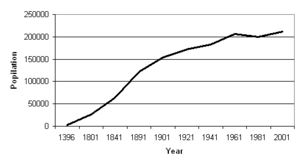
| Aberdeen compared[45] | |||
|---|---|---|---|
| UK Census 2011 | Aberdeen | Scotland | |
| Total population | 222,793 | 5,295,000 | |
| Population growth 2001–2011 | 5.0% | 5.0% | |
| White | 91.9% | 96.0% | |
| Asian | 4.3% | 2.7% | |
| Black | 2.6% | 0.8% | |
| Christian | 30.9% | 54.0% | |
| Muslim | 1.9% | 1.4% | |
The latest population estimate (mid 2012) for the urban area of Aberdeen is 196,670.[1] For the wider settlement of Aberdeen including Cove Bay and Dyce the latest population estimate (mid 2012) is 209,460.[1] For the local council area of Aberdeen City the latest estimate (mid 2017) is 227,560[6]
In 1396 the population was about 3,000. By 1801 it had become 26,992; (1901) 153,503; (1941) 182,467.[46]
The 2011 census showed that there are fewer young people in Aberdeen, with 16.4% under 16, opposed to the national average of 19.2%.[47] According to the 2011 census Aberdeen is 91.9% white, ethnically, 24.7% were born outside Scotland, higher than the national average of 16%. Of this population 7.6% were born in other parts of the UK.[45] 8.2% of Aberdonians stated to be from an ethnic minority (non-white) in the 2011 census, with 9,519 (4.3%) being Asian, with 3,385 (1.5%) coming from India and 2,187 (1.0%) being Chinese. The city has around 5,610 (2.6%) residents of African or Caribbean origin, which is a higher percentage than both Glasgow and Edinburgh.[45]
In the household, there were 97,013 individual dwellings recorded in the city of which 61% were privately owned, 9% privately rented and 23% rented from the council. The most popular type of dwellings are apartments which comprise 49% of residences followed by semi-detached at just below 22%.[48] The median income of a household in the city is £16,813 (the mean income is £20,292)[49] (2005) which places approximately 18% households in the city below the poverty line (defined as 60% of the mean income). Conversely, an Aberdeen postcode has the second highest number of millionaires of any postcode in the UK.[50]
Religion
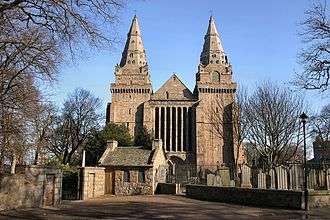
Christianity is the main religion practised in the city. Aberdeen's largest denominations are the Church of Scotland (through the Presbytery of Aberdeen) and the Roman Catholic Church, both with numerous churches across the city, with the Scottish Episcopal Church having the third-largest number. The most recent census in 2001 showed that Aberdeen has the highest proportion of non-religious residents of any city in Scotland, with nearly 43% of citizens claiming to have no religion[47] and several former churches in the city have been converted into bars and restaurants. In the Middle Ages, the Kirk of St Nicholas was the only burgh kirk and one of Scotland's largest parish churches. Like a number of other Scottish kirks, it was subdivided after the Reformation, in this case into the East and West churches. At this time, the city also was home to houses of the Carmelites (Whitefriars)[51] and Franciscans (Greyfriars), the latter of which surviving in modified form as the chapel of Marischal College as late as the early 20th century.
St Machar's Cathedral was built twenty years after David I (1124–1153) transferred the pre-Reformation Diocese from Mortlach in Banffshire to Old Aberdeen in 1137. With the exception of the episcopate of William Elphinstone (1484–1511), building progressed slowly. Gavin Dunbar, who followed him in 1518, completed the structure by adding the two western spires and the southern transept. It is now a congregation of the Church of Scotland. Aberdeen has two other cathedrals: St. Mary's Cathedral is a Roman Catholic cathedral in Gothic style, erected in 1859. In addition, St. Andrew's Cathedral serves the Scottish Episcopal Church. It was constructed in 1817 as Archibald Simpson's first commission and contains a memorial to the consecration of the first bishop of the Episcopal Church in the United States of America, which took place nearby. In 1804, St Peter's Church, the first permanent Roman Catholic church in the city after the Reformation was built.[52]

Numerous other Protestant denominations have a presence in Aberdeen. The Salvation Army citadel on the Castlegate dominates the view of east end of Union Street. In addition, there is a Unitarian church, established in 1833 and located in Skene Terrace. Christadelphians have been present in Aberdeen since at least 1844. Over the years, they have rented space to meet at a number of locations and currently meet in the Inchgarth Community Centre in Garthdee.[53] There is also a Quaker meetinghouse on Crown street, the only purpose built Quaker House in Scotland that is still in use today. In addition, there are a number of Baptist congregations in the city, and Evangelical congregations have been appearing in significant numbers since the late 2000s. The city also has two meetinghouses of The Church of Jesus Christ of Latter-day Saints (LDS Church).
There is also a mosque in Old Aberdeen which serves the Islamic community in the city, and an Orthodox Jewish Synagogue established in 1945. There is also a Thai Buddhist temple located in the Hazelhead area of the city. There are no formal Hindu buildings, although the University of Aberdeen has a small Bahá'í society and there is a fortnightly Hindu religious gathering in the 1st and 3rd Sunday afternoons at Queens Cross Parish church hall.[54]
Economy

Traditionally, Aberdeen was home to fishing, textile mills, shipbuilding and paper making. These industries have been largely replaced. High technology developments in the electronics design and development industry, research in agriculture and fishing and the oil industry, which has been largely responsible for Aberdeen's economic boom in the last three decades, are now major parts of Aberdeen's economy.
Until the 1970s, most of Aberdeen's leading industries dated from the 18th century; mainly these were textiles, foundry work, shipbuilding and paper-making, the oldest industry in the city, with paper having been first made there in 1694. Paper-making has reduced in importance since the closures of Donside Paper Mill in 2001 and the Davidson Mill in 2005 leaving the Stoneywood Paper Mill with a workforce of approximately 500. Textile production ended in 2004 when Richards of Aberdeen closed.
Grey granite was quarried at Rubislaw quarry for more than 300 years, and used for paving setts, kerb and building stones, and monumental and other ornamental pieces. Aberdeen granite was used to build the terraces of the Houses of Parliament and Waterloo Bridge in London. Quarrying finally ceased in 1971. The current owners have begun pumping 40 years of rain water from the quarry with the aim of developing a heritage centre on the site.[55]
Fishing was once the predominant industry, but was surpassed by deep-sea fisheries, which derived a great impetus from improved technologies throughout the 20th century. Catches have fallen because of overfishing and the use of the harbour by oil support vessels,[56] and so although still an important fishing port it is now eclipsed by the more northerly ports of Peterhead and Fraserburgh. The Fisheries Research Services are headquartered in Aberdeen, and there is a marine research lab in Torry.
Aberdeen is well regarded for the agricultural and soil research carried out at The James Hutton Institute (formerly the Macaulay Land Use Research Institute), which has close links to the city's two universities. The Rowett Research Institute is a world-renowned research centre for studies into food and nutrition located in Aberdeen. It has produced three Nobel laureates and there is a high concentration of life scientists working in the city.[57][58]
As oil reserves in the North Sea decrease there is an effort to rebrand Aberdeen as "Energy Capital of Europe" rather than "Oil Capital of Europe", and there is interest in the development of new energy sources; and technology transfer from oil into renewable energy and other industries is under way. The "Energetica" initiative led by Scottish Enterprise has been designed to accelerate this process.[59] As of 2013, Aberdeen remained a major world centre for undersea petroleum technology.[60]
Aberdeen and the North Sea
Aberdeen had been a major maritime centre throughout the 19th century, when a group of local entrepreneurs launched the first steam-powered trawler. The steam trawling industry expanded and by 1933 Aberdeen was Scotland's top fishing port, employing nearly 3,000 men with 300 vessels sailing from its harbour. By the time oil was coming on stream, much of the trawling fleet had relocated to Peterhead. Although Aberdeen still brings in substantial catches, the tugs, safety vessels and supply ships which pack the harbour far outnumber the trawlers.

Geologists had speculated about the existence of oil and gas in the North Sea since the middle of the 20th century, but tapping its deep and inhospitable waters was another story. With the Middle Eastern oil sheiks becoming more aware of the political and economic power of their oil reserves and government threats of rationing, the industry began to consider the North Sea as a viable source of oil. Exploration commenced in the 1960s and the first major find in the British sector was in November 1970 in the Forties field, 110 miles (180 km) east of Aberdeen.
By late 1975, after years of intense construction the necessary infrastructure was in place. In Aberdeen, at BP's (British Petroleum) headquarters, the Queen pressed the button that would set the whole thing moving. Oil flowed from the rig directly to the refinery at far-away Grangemouth. While many ports have suffered decline, Aberdeen remains busy because of the oil trade and the influx of people connected with the industry, a subsequent rise in property prices have brought prosperity to the area.
The industry supports about 47,000 jobs locally, and known reserves ensure that oil will continue to flow well into the 21st century. As a major port in the UK, Aberdeen receives many ships calling at the port. Seafarers' welfare organisation, Apostleship of the Sea has a port chaplain in Aberdeen to offer practical and pastoral support to them.
Business
In 2011, the Centre for Cities named Aberdeen as the best placed city for growth in Britain, as the country looked to emerge from the recent economic downturn.[61] With energy still providing the backbone of the local economy, recent years have seen very large new investment in the North Sea owing to rising oil prices and favourable government tax incentives.[62] This has led to several oil majors and independents building new global offices in the city.[63]
Aberdeen City and Shire's Gross Domestic Product is estimated at over £11.4 billion, accounting for over 17% of the overall Scottish GDP. Five of Scotland's top ten businesses are based in Aberdeen with a collective turnover of £14 billion, yielding a profit in excess of £2.4 billion. Alongside this 29 of Scotland's top 100 businesses are located in Aberdeen with an employment rate of 77.9%, making it the 2nd highest UK city for employment.[64]
Figures released in 2016 ranked Aberdeen as having the second highest amount of patents processed per person in the UK.[65]
Shopping
The traditional shopping streets are Union Street and George Street, now complemented by shopping centres, notably the Bon Accord Centre and the Trinity Shopping Centre. A£190 million[66] retail development, Union Square, reached completion in late September/early October 2009. Major retail parks away from the city centre include the Berryden Retail Park, the Kittybrewster Retail Park and the Beach Boulevard Retail Park.
In March 2004, Aberdeen was awarded Fairtrade City status by the Fairtrade Foundation.[67] Along with Dundee, it shares the distinction of being the first city in Scotland to receive this accolade.
Landmarks
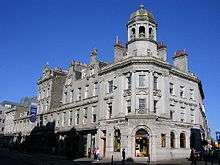
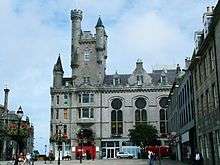
Aberdeen's architecture is known for its principal use during the Victorian era of granite, which has led to its local nickname of the Granite City or more romantically the less commonly used name the Silver City, since the Mica in the stone sparkles in the sun. The hard grey stone is one of the most durable materials available and helps to explain why the city's buildings look brand-new when they have been newly cleaned and the cement has been pointed. Unlike other Scottish cities where sandstone has been used, the buildings are not weathering and need very little structural maintenance on their masonry. The buildings can however become noticeably darker as a result of pollution and grime accumulated over the years. There has however been great success in cleaning the buildings which can result in their façade being restored back to much how they looked originally.
Amongst the notable buildings in the city's main street, Union Street, are the Town and County Bank, the Music Hall, the Trinity Hall of the incorporated trades (originating between 1398 and 1527, although completely rebuilt in the 1860s), now a shopping mall; the former office of the Northern Assurance Company, and the National Bank of Scotland. In Castle Street, a continuation eastwards of Union Street, is the new Aberdeen Town House, a very prominent landmark in Aberdeen, built between 1868 and 1873 to a design by Peddie and Kinnear.[68]
Alexander Marshall Mackenzie's extension to Marischal College on Broad Street, opened by King Edward VII in 1906, created the second largest granite building in the world (after the Escorial, Madrid).[69]
In addition to the many fine landmark buildings, Aberdeen has many prominent public statues, three of the most notable being William Wallace at the junction between Union Terrace and Rosemount Viaduct, Robert Burns on Union Terrace above Union Terrace Gardens, and Robert the Bruce holding aloft the charter he issued to the city in 1319 on Broad Street, outside Marischal College.
Parks, gardens and open spaces
Aberdeen has long been famous for its 45[70] parks and gardens, and citywide floral displays which include two million roses, eleven million daffodils and three million crocuses. The city has won the Royal Horticultural Society's Britain in Bloom 'Best City' award ten times,[70] the overall Scotland in Bloom competition twenty times[70] and the large city category every year since 1968.[70] However, despite recent spurious reports, Aberdeen has never been banned from the Britain in Bloom competition.[71] The city won the 2006 Scotland in Bloom "Best City" award along with the International Cities in Bloom award. The suburb of Dyce also won the Small Towns award.[72][73]
Duthie Park opened in 1899 on the north bank of the River Dee. It was named after and given to the city by Miss Elizabeth Crombie Duthie of Ruthrieston in 1881. It has extensive gardens, a rose hill, boating pond, bandstand, and play area as well as Europe's second largest enclosed gardens the David Welch Winter Gardens. Hazlehead Park, is large and forested, located on the outskirts of the city, it is popular with walkers in the forests, sports enthusiasts, naturalists and picnickers. There are football pitches, two golf courses, a pitch and putt course and a horse riding school.
Aberdeen's success in the Britain in Bloom competitions is often attributed to Johnston Gardens, a small park of one hectare in the west end of the city containing many different flowers and plants which have been renowned for their beauty. In 2002, the garden was named the best garden in the British Islands.[70] Seaton Park, formerly the grounds of a private house, is on the edge of the grounds of St Machar's Cathedral. The Cathedral Walk is maintained in a formal style with a great variety of plants providing a popular display. The park includes several other areas with contrasting styles to this. Union Terrace Gardens opened in 1879 and is situated in the centre of the city. It covers 2.5 acres (1.0 ha) in the centre of Aberdeen bordered on three sides by Union Street, Union Terrace and Rosemount Viaduct. The park forms a natural amphitheatre located in the Denburn Valley and is an oasis of peace and calm in the city centre. A recent proposal to build a three-storey concrete and steel superstructure in place of the gardens, part of which will provide a commercial concourse, has proved highly controversial.
Situated next to each other, Victoria Park and Westburn Park cover 26 acres (11 ha) between them. Victoria Park opened in 1871. There is a conservatory used as a seating area and a fountain made of fourteen different granites, presented to the people by the granite polishers and master builders of Aberdeen. Opposite to the north is Westburn Park opened in 1901. With large grass pitches it is widely used for field sports. There is large tennis centre with indoor and outdoor courts, a children's cycle track, play area and a grass boules lawn.
Theatres and concert halls
Aberdeen has hosted several theatres throughout its history, some of which have subsequently been converted or destroyed. The most famous include:
- His Majesty's Theatre (HMT), on Rosemount Viaduct[74]
- The Tivoli, on Guild Street[75]
- Capitol Theatre, on Union Street
- Aberdeen Arts Centre, on King Street
- The Palace Theatre, on Bridge Street[76]
- The Lemon Tree on West North Street
The main concert hall is the Music Hall on Union Street, built in 1822.
Transport
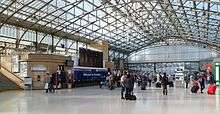
Aberdeen Airport (ABZ), at Dyce in the north of the city, serves domestic and international destinations including France, Germany, the Netherlands, Spain, Belgium, Austria, Ireland and Scandinavian countries. The heliport which serves the oil industry and rescue services is one of the world's busiest commercial heliports.[11]
Aberdeen railway station is on the main UK rail network and Abellio ScotRail has frequent direct trains to major cities Edinburgh, Glasgow and Inverness. London North Eastern Railway and the Caledonian Sleeper operate direct trains to London. In 2007 additions were made and a new ticket office was built in the building. The UK's longest direct rail journey runs from Aberdeen to Penzance. It is operated by CrossCountry, leaving Aberdeen at 08:20 and taking 13 hours and 23 minutes. Today, all railway services to the south run via Dundee. The faster main line from Aberdeen to Perth via Forfar and Strathmore closed in 1967 as a result of the Beeching cuts, and the faster main line from Perth to Edinburgh via Glenfarg also subsequently closed in 1970.
Until 2007, a 1950s-style concrete bus station at Guild Street served out-of-the-city locations; it has since transferred to a new and well-presented bus station just 100 metres to the east off Market Street as part of the Union Square development.
There are six major roads in and out of the city. The A90 is the main arterial route into the city from the north and south, linking Aberdeen to Edinburgh, Dundee, Brechin and Perth in the south and Ellon, Peterhead and Fraserburgh in the north. The A96 links Elgin and Inverness and the north west. The A93 is the main route to the west, heading towards Royal Deeside and the Cairngorms. After Braemar, it turns south, providing an alternative tourist route to Perth. The A944 also heads west, through Westhill and on to Alford. The A92 was the original southerly road to Aberdeen prior to the building of the A90, and is now used as a tourist route, connecting the towns of Montrose and Arbroath and on the east coast. The A947 exits the city at Dyce and goes on to Newmachar, Oldmeldrum and Turriff finally ending at Banff and Macduff.
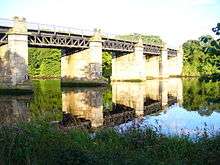
After first being mooted some 60 years ago and being held up for the past five years by a number of legal challenges, Aberdeen's long-awaited Western Peripheral Route was given the go-ahead after campaigners lost their appeal to the UK Supreme Court in October 2012. The 30-mile (50 km) route was earmarked to be completed in 2018 and was hoped to significantly reduce traffic congestion in and around the city.[77] Aberdeen Harbour is important as the largest in the north of Scotland and serves the ferry route to Orkney and Shetland. Established in 1136, the harbour has been referred to as the oldest business in Britain.[78]
FirstGroup operates the city buses under the name First Aberdeen, as the successor of Grampian Regional Transport (GRT) and Aberdeen Corporation Tramways. Aberdeen is the global headquarters of FirstGroup plc, having grown from the GRT Group. First is still based at the former Aberdeen Tramways depot on King Street,[79] which has now been redeveloped into a new Global Headquarters and Aberdeen bus depot. Stagecoach East Scotland also run buses in Aberdeen and Aberdeenshire, under the Stagecoach Bluebird brand. Megabus run buses from the bus station to places north and south of the city.
National Express operate express coach services to London twice daily. The 590 service, operated by Bruce's Coaches of Salsburgh operates in the morning and runs through the day, calling at Dundee, Perth, Glasgow, Hamilton, Carlisle, Milton Keynes, Golders Green and Victoria Coach Station, whilst the 592 (operated by Parks of Hamilton) leaves in the evening and travels overnight, calling at Dundee, Glasgow, Hamilton, Carlisle, Heathrow Airport and Victoria Coach Station. In addition, there are Megabus services to London and Edinburgh and Scottish Citylink services to Glasgow, operated by Stagecoach East Scotland and Parks of Hamilton using the Citylink gold and blue livery.
Aberdeen is connected to the UK National Cycle Network, and has a track to the south connecting to cities such as Dundee and Edinburgh and one to the north that forks about 10 miles (15 km) from the city into two different tracks heading to Inverness and Fraserburgh respectively. Two popular footpaths along old railway tracks are the Deeside Way to Banchory (which will eventually connect to Ballater) and the Formartine and Buchan Way to Ellon, both used by a mixture of cyclists, walkers and occasionally horses. Four park-and-ride sites serve the city: Stonehaven and Ellon (approx 12 to 17 miles (19 to 27 km) out from the city centre) and Kingswells and Bridge of Don (approx 3 to 4 miles (5 to 6 km) out).
The Dee Estuary, Aberdeen's harbour, has continually been improved. Starting out as a fishing port, moving onto steam trawlers, the oil industry, it is now a major port of departure for the Baltic and Scandinavia.[80] Major exports include fertiliser, granite, and chemicals.
Education
Universities and colleges
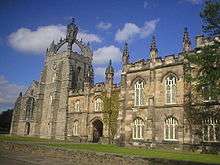
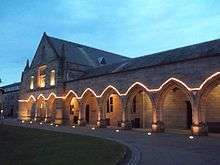
Aberdeen has two universities, the ancient University of Aberdeen, and Robert Gordon University, a modern university often referred to as RGU. Aberdeen's student rate of 11.5% is higher than the national average of 7%.[81]
The University of Aberdeen began as King's College, Aberdeen, which was founded in 1495[80] by William Elphinstone (1431–1514), Bishop of Aberdeen and Chancellor of Scotland. Marischal College, a separate institution, was founded in "New" Aberdeen by George Keith, fifth Earl Marischal of Scotland in 1593.[80] These institutions were merged by order of Parliament in 1860 to form the University of Aberdeen.[80] The university is the fifth oldest in the English-speaking world[82] and offers degrees in a full range of disciplines. Its main campus is in Old Aberdeen in the north of the city and it currently has approximately 14,000 students. The university's debating society is the oldest in Scotland, founded in 1848 as the King's College Debating Society.[83] Today, Aberdeen is consistently ranked among the top 200 universities in the world[84] and is ranked within the top 30 universities in the United Kingdom.[85][86] Aberdeen was also named the 2019 Scottish University of the Year by The Times and Sunday Times Good University Guide.[87]
Robert Gordon's College (originally Robert Gordon's Hospital) was founded in 1750 by the merchant Robert Gordon,[80] grandson of the map maker Robert Gordon of Straloch, and was further endowed in 1816 by Alexander Simpson of Collyhill. Originally devoted to the instruction and maintenance of the sons of poor burgesses of guild and trade in the city, it was reorganised in 1881 as a day and night school for secondary and technical education. In 1903, the vocational education component of the college was designated a Central Institution and was renamed as the Robert Gordon Institute of Technology in 1965. In 1992, university status was awarded and it became Robert Gordon University.[88] The university has expanded and developed significantly in recent years, and was named Best Modern University in the UK for 2012 by The Sunday Times. It was previously The Sunday Times Scottish University of the Year for 2011, primarily because of its record on graduate employment. The citation for the 2011 award read: "With a graduate unemployment rate that is lower than the most famous universities, including Oxford and Cambridge, plus a flourishing reputation for research, high student satisfaction rates and ambitious plans for its picturesque campus, the Robert Gordon University is The Sunday Times Scottish University of the Year".[89]
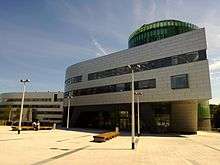
RGU had two campuses: one in the city centre at Schoolhill/St. Andrew Street and a larger suburban campus at Garthdee and currently has approximately 15,500 students. As of 2013, the Garthdee campus was expanded to include all schools, with the Schoolhill/St. Andrew Street campus being sold to Robert Gordon's College, and the building now functions as the school's Science and Technology Centre. The closure of the Schoolhill site includes the removal of the Student Union building, giving Aberdeen the dubious distinction of having two universities but no student bar.

Aberdeen is also home to two artistic schools: Gray's School of Art, founded in 1886, which is one of the oldest established colleges of art in the UK. Scott Sutherland School of Architecture and Built Environment, was one of the first architectural schools to have its training courses recognised by the Royal Institute of British Architects. Both are now part of Robert Gordon University and are based at its Garthdee campus. North East Scotland College has several campuses in the city and offers a wide variety of part-time and full-time courses leading to several different qualifications in science. The Scottish Agricultural College is based just outside Aberdeen, on the Craibstone Estate. This is situated beside the roundabout for Aberdeen Airport on the A96. The college provides three services—Learning, Research and Consultancy. The college features many land based courses such as Agriculture, Countryside Management, Sustainable Environmental Management and Rural Business Management. There are a variety of courses from diplomas through to master's degrees. The Marine Laboratory Aberdeen, which specialises in fisheries, Macaulay Land Use Research Institute (soil science), and the Rowett Research Institute (animal nutrition) are some other higher education institutions.[80]
The Aberdeen College of Performing Arts also provides full-time Drama and Musical Theatre training at Further Education level.
Schools
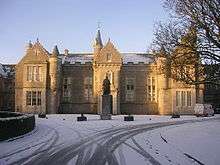
There are currently 12 secondary schools and 54 primary schools which are run by the city council. The most notable are Aberdeen Grammar School (founded in 1257), Harlaw Academy, Cults Academy, and Oldmachar Academy which were all rated in the top 50 Scottish secondary schools league tables published by The Times in 2005. Harlaw Academy was taken down from the list after a short time but is still a popular school.[90] There are a number of private schools in Aberdeen: Robert Gordon's College, Albyn School for Girls (co-educational as of 2005), St Margaret's School for Girls, the Hamilton School (closed by the Child Care Inspectorate in early 2014), the Total French School (for French oil industry families), the International School of Aberdeen and a Waldorf/Steiner School.
Primary schools in Aberdeen include Airyhall Primary School, Albyn School, Ashley Road Primary School, Balgownie Primary School, Broomhill Primary School, Cornhill Primary School (the city's largest), Culter Primary School, Cults Primary School, Danestone Primary School, Fernielea Primary school, Ferryhill Primary School, Gilcomstoun Primary School, Glashieburn Primary School, Greenbrae School, Hamilton School, Kaimhill Primary School, Kingsford Primary School, Kittybrewster Primary School, Middleton Park Primary School, Mile-End School, Muirfield Primary School, Robert Gordon's College, Skene Square Primary School, St. Joseph's Primary School and St Margaret's School for Girls.
Culture
Museums and galleries

The city has a wide range of cultural activities, amenities and museums.[92] The city is regularly visited by Scotland's National Arts Companies. The Aberdeen Art Gallery houses a collection of Impressionist, Victorian, Scottish and 20th-century British paintings as well as collections of silver and glass. It also includes The Alexander Macdonald Bequest, a collection of late 19th-century works donated by the museum's first benefactor and a constantly changing collection of contemporary work and regular visiting exhibitions.[93]
The Aberdeen Maritime Museum, located in Shiprow, tells the story of Aberdeen's links with the sea from the days of sail and clipper ships to the latest oil and gas exploration technology. It includes an 8.5-metre-high (28 ft) model of the Murchison oil production platform and a 19th-century assembly taken from Rattray Head lighthouse Provost Ross' House is the second oldest dwelling house in the city. It was built in 1593 and became the residence of Provost John Ross of Arnage in 1702. The house retains some original medieval features, including a kitchen, fireplaces and beam-and-board ceilings.[94] The Gordon Highlanders Museum tells the story of one of Scotland's best known regiments.[95]
Marischal Museum holds the principal collections of the University of Aberdeen, comprising some 80,000 items in the areas of fine art, Scottish history and archaeology, and European, Mediterranean and Near Eastern archaeology. The permanent displays and reference collections are augmented by regular temporary exhibitions.[96] It closed to the public in 2008 for renovations; its reopening date has yet to be confirmed.[97] The King's Museum acts as the main museum of the university in the meantime.
Festivals and performing arts
Aberdeen is home to a number of events and festivals including the Aberdeen International Youth Festival (the world's largest arts festival for young performers), Aberdeen Jazz Festival, Aberdeen Alternative Festival, Rootin' Aboot (a folk and roots music event), Triptych, the University of Aberdeen's literature festival Word and DanceLive, Scotland's only Festival of contemporary dance, which is produced by the city's Citymoves dance organisation.
The Aberdeen Student Show, performed annually without interruption since 1921, under the auspices of the Aberdeen Students' Charities Campaign, is the longest-running of its kind in the United Kingdom. It is written, produced and performed by students and graduates of Aberdeen's universities and higher education institutions. Since 1929—other than on a handful of occasions—it has been staged at His Majesty's Theatre. The Student Show traditionally combines comedy and music, inspired by the North-East's Doric dialect and humour.
National festivals which visited Aberdeen in 2012 included the British Science Festival in September, hosted by the University of Aberdeen but with events also taking place at Robert Gordon University and at other venues across the city. In February 2012 the University of Aberdeen also hosted the Inter Varsity Folk Dance Festival, the longest running folk festival in the United Kingdom.
Music and film

Aberdeen's music scene includes a variety of live music venues including pubs, clubs, and church choirs. The bars of Belmont Street are particularly known for featuring live music. Ceilidhs are also common in the city's halls. Popular music venues include the Aberdeen Exhibition and Conference Centre (AECC), Aberdeen Music Hall, along with smaller venues such as The Tunnels, The Moorings, Drummonds, Downstairs, The Lemon Tree and The Garage. Notable Aberdonian musicians include Annie Lennox, Emeli Sandé, Chris Burke, cult band Pallas and contemporary composer John McLeod. There are many local bands including Grader, Sleepless, Hayworth, Deceptions, Without Reason, Monroe and Deadfire A large proportion of Aberdeen's classical music scene is based around the ensembles of Aberdeen University's music department, notably the Symphony Orchestra, Marischal Chamber Orchestra, and the Concert Band.
Cultural cinema, educational work and local film events are provided by The Belmont Picturehouse on Belmont Street, Peacock Visual Arts and The Foyer. The only Doric speaking feature film was released in 2008 by Stirton Productions and Canny Films. One Day Removals is a black comedy/adult drama starring Patrick Wight and Scott Ironside and tells the tale of two unlucky removal men whose day goes from bad to worse. It was filmed on location in Aberdeenshire for a budget of £60,000.
Dialect
The local dialect of Lowland Scots is often known as Doric, and is spoken not just in the city, but across the north-east of Scotland. It differs somewhat from other Scots dialects most noticeable are the pronunciation f for what is normally written wh and ee for what in standard English would usually be written oo (Scots ui). Every year the annual Doric Festival[98] takes place in Aberdeenshire to celebrate the history of the north-east's language. As with all Scots dialects in urban areas, it is not spoken as widely as it used to be in Aberdeen.
Media
Aberdeen is home to Scotland's oldest newspaper the Press and Journal, a local and regional newspaper first published in 1747. The Press and Journal and its sister paper the tabloid Evening Express are printed six days a week by Aberdeen Journals. There is one free newspaper, the Aberdeen Citizen. BBC Scotland has a network studio production base in the city's Beechgrove area, and BBC Aberdeen produces The Beechgrove Potting Shed for radio while Tern Television produces The Beechgrove Garden television programme.[99] The city is also home to STV North (formerly Grampian Television), which produces the regional news programmes such as STV News at Six, as well as local commercials. The station, based at Craigshaw Business Park in Tullos, was based at larger studios in Queens Cross from September 1961 until June 2003.
There are three commercial radio stations operating in the city: Northsound Radio, which runs Northsound 1 and Northsound 2, and independent station Original 106. Other radio stations include NECR FM (North-East Community Radio FM) DAB station,[100] and shmu FM[101] managed by Station House Media Unit[102] which supports community members to run Aberdeen's first (and only) full-time community radio station, broadcasting on 99.8 MHz FM.
Food
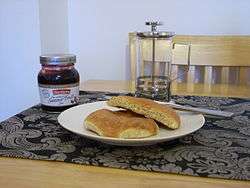
The Aberdeen region has given its name to a number of dishes, including the Aberdeen buttery (also known as "rowie")[103] and Aberdeen Sausage.[104] The Aberdeen buttery is more frequently seen and is sold at bakeries and supermarkets throughout the city. It is comparable to a croissant that is flat and round with a buttery, savoury taste and flaky texture. It is often toasted and served plain or with butter or jam.
In 2015, a study was published in The Scotsman which analysed the presence of branded fast food outlets in Scotland. Of the ten towns and cities analysed, Aberdeen was found to have the lowest per capita concentration, with just 0.12 stores per 1,000 inhabitants.[105]
Sport
Football
The first ever recorded game of football, was outlined by teacher David Wedderburn in his book "Vocabula" [106] written in 1633, during his time teaching at Aberdeen Grammar School. Only 42 miles south of Aberdeen in Montrose, Helen Matthews was born. A suffragette, known as Mrs Graham, she created the first known women's football team, which beat England 3-1 in their second match in May 1881.
The mens game started in Aberdeen, the womens game was started by Helen Matthews from nearby Montrose.

There are two Aberdeen-based football clubs in the SPFL, the senior branch of Scottish football. Aberdeen F.C. ( The Dons) play in the Scottish Premiership at Pittodrie Stadium. The club won the European Cup Winners Cup and the European Super Cup in 1983, the Scottish Premier League Championship four times (1955, 1980, 1984 and 1985), and the Scottish Cup seven times (1947, 1970, 1982, 1983, 1984, 1986 and 1990). Under the management of Alex Ferguson, Aberdeen was a major force in British football during the 1980s. As of the 2019–20 season, the club is managed by Derek McInnes. There are plans to build a new Aberdeen Stadium in the future. Under the management of McInnes the team won the 2014 Scottish League Cup and followed it up with a second place league finish for the first time for more than 20 years in the following season.
The other senior team is Cove Rangers of League Two, who play at Balmoral Stadium in the suburb of Cove Bay. Cove won the Highland Football League championship in 2001, 2008, 2009, 2013 and 2019, winning the League Two play-offs in 2019 and earning promotion. This means that the city of Aberdeen has two clubs in Scottish football's senior leagues for the first time in history.
There was also a historic senior team Bon Accord F.C. who no longer play. Local junior teams include Banks O' Dee F.C., Culter F.C., F.C. Stoneywood, Glentanar F.C., Sunnybank and Hermes F.C..
Rugby Union
Aberdeen hosted Caledonia Reds a Scottish rugby team, before they merged with the Glasgow Warriors in 1998. The city is also home to the Scottish Premiership Division One rugby club Aberdeen GSFP RFC who play at Rubislaw Playing Fields, and Aberdeenshire RFC which was founded in 1875 and runs Junior, Senior Men's, Senior Ladies and Touch sections from the Woodside Sports Complex[107] and also Aberdeen Wanderers RFC. Former Wanderers' player Jason White was captain of the Scotland national rugby union team.
Aberdeenshire Rugby Football Club is based in the North of the city at Woodside Sports Complex[108] near the Great North Road on the banks of the river Don. They currently play in the Scottish League Championship B (East), the 3rd tier of club rugby.
In 2005 the President of the SRU said it was hoped eventually to establish a professional team in Aberdeen.[109] In November 2008 the city hosted a rugby international at Pittodrie between Scotland and Canada, with Scotland winning 41–0.[110] In November 2010 the city once again hosted a rugby international at Pittodrie between Scotland and Samoa, with Scotland winning 19–16.[111]
Rugby League
Aberdeen Warriors rugby league team play in the Rugby League Conference Division One. The Warriors also run Under 15's and 17's teams. Aberdeen Grammar School won the Saltire Schools Cup in 2011.[112]
Golf
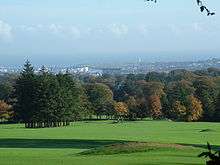
The Royal Aberdeen Golf Club, founded in 1780 is the sixth oldest golf club in the world, and hosted the Senior British Open in 2005, and the amateur team event the Walker Cup in 2011.[113] Royal Aberdeen also hosted the Scottish Open in 2014, won by Justin Rose.[114] The club has a second course, and there are public golf courses at Auchmill, Balnagask, Hazlehead and King's Links.[115] The 1999 winner of The Open Championship, Paul Lawrie, is from Aberdeen.
There are new courses planned for the area, including world class facilities with major financial backing, the city and shire are set to become a hotbed for golf tourism. In Summer 2012, Donald Trump opened a new state of the art golf course at Menie, just north of the city, as the Trump International Golf Links, Scotland.
Swimming
The City of Aberdeen Swim Team (COAST) was based in Northfield swimming pool, but since the opening of the Aberdeen Aquatics Centre in 2014, it is now based there, as it has a 50 m pool as opposed to the 25 m pool at Northfield. It has been in operation since 1996. The team comprises several smaller swimming clubs, and has enjoyed success throughout Scotland and in international competitions. Three of the team's swimmers qualified for the 2006 Commonwealth Games.[116]
Rowing

There are four boat clubs that row on the River Dee: Aberdeen Boat Club (ABC), Aberdeen Schools Rowing Association (ASRA), Aberdeen University Boat Club (AUBC) and Robert Gordon University Boat Club (RGUBC). There are regattas and head races annually, managed by the Committee of the Dee. There is also a boat race held every year between AUBC and RGUBC. The race is in mixed eights, and usually held in late February / early March.
Cricket
Aberdeen boasts a large cricket community with 4 local leagues operating that comprise a total of 25 clubs fielding 36 teams. The city has two national league sides, Aberdeenshire and Stoneywood-Dyce. Local 'Grades'[117] cricket has been played in Aberdeen since 1884. Aberdeenshire were the 2009 & 2014 Scottish National Premier League and Scottish Cup Champions, but now face relegation in the 2019 season[118]
Ice hockey
Aberdeen Lynx are an amateur ice hockey team who play in the Scottish National League and are based at the Linx Ice Arena. The arena has a seating capacity of 1,100. They were play-off champions in season 2015–2016. The club also field teams at the Under 20, Under 16, Under 14 and Under 12 age groups.
Shinty
Aberdeen University Shinty Club (Scottish Gaelic:Club Camanachd Oilthigh Obar Dheathain) is the oldest constituted shinty club in the world, dating back to 1861. The team plays its home games at Balgownie in the Bridge of Don.
Other sports
The city council operates public tennis courts in various parks including an indoor tennis centre at Westburn Park. The Beach Leisure Centre is home to a climbing wall, gymnasium and a swimming pool. There are numerous swimming pools dotted around the city notably the largest, the Bon-Accord Baths which closed down in 2006.[119]
Aberdeen City council also have an outdoor education service which is now known as adventure aberdeen, that provides abseiling, surfing, white water rafting, gorge walking, kayaking and open canoeing, mountaineering, sailing, mountain biking and rock climbing. They say they aim to "Inspire learning through adventure", and have many programs for children and adults.[120]
In common with many other major towns and cities in the UK, Aberdeen has an active roller derby league, Granite City Roller Girls.[121] The Aberdeen Roughnecks American football club are a new team which started in 2012. They are an adult contact team who currently train at Seaton Park. This is the first team which Aberdeen has enjoyed since the Granite City Oilers were wound up in the late 1990s. Aberdeen Oilers Floorball Club was founded in 2007. The club initially attracted a range of experienced Scandinavian and other European players who were studying in Aberdeen. Since their formation, Aberdeen Oilers have played in the British Floorball Northern League and went on to win the league in the 2008/09 season. The club played a major role in setting up a ladies league in Scotland. The Oilers' ladies team ended up second in the first ladies league season (2008/09).[122]
Public services
The public health service in Scotland, NHS Scotland provides for the people of Aberdeen through the NHS Grampian health board. Aberdeen Royal Infirmary is the largest hospital in the city and one of the largest in Europe[123][124] (the location of the city's A&E department), Royal Aberdeen Children's Hospital, a paediatric hospital, Royal Cornhill Hospital for mental health, Aberdeen Maternity Hospital, an antenatal hospital, Woodend Hospital, which specialises in rehabilitation and long-term illnesses and conditions, and City Hospital and Woolmanhill Hospital, which host several out-patient clinics and offices.
Albyn Hospital is a private hospital located in the west end of the city.
Aberdeen City Council is responsible for city owned infrastructure which is paid for by a mixture of council tax and income from HM Treasury. Infrastructure and services run by the council include: clearing snow in winter, city wardens, maintaining parks, refuse collection, sewage, street cleaning and street lighting. Infrastructure in private hands includes electricity, gas and telecoms. Water supplies are provided by Scottish Water.
- Police: Policing in Aberdeen is the responsibility of Police Scotland (the British Transport Police has responsibility for railways). The Grampian Division of Police Scotland headquarters (and Aberdeen divisional headquarters) is located in Queen Street, Aberdeen.
- Ambulance: The North East divisional headquarters of the Scottish Ambulance Service is located in Aberdeen.[125]
- Fire and rescue: This is the responsibility of the Scottish Fire and Rescue Service.
- Lifeboat: The Royal National Lifeboat Institution operates Aberdeen Lifeboat Station. It is located at Victoria Dock Entrance in York Place.[126] The current building was opened in 1997.
Twin cities
Aberdeen is twinned with




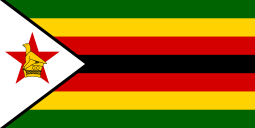


Notable people
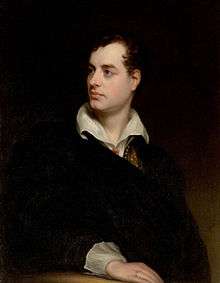
- Ara Paiaya, film producer and director of Skin Traffik, Instant Death and Purge of Kingdoms.
- Leslie Benzies, Former president of Rockstar North, creators of the critically acclaimed Grand Theft Auto series.
- Scott Booth, former football player, played for Aberdeen F.C., FC Twente, Borussia Dortmund and the Scottish national football team.
- Alf Burnett, footballer who played for Dundee United
- Chris Burke, electronic dance music DJ and record producer.
- Lord Byron FRS (1788 – 1824), poet, was raised (age 2–10) in Aberdeen.
- David Carry, swimmer, 2x 2006 Commonwealth Games gold medallist.
- Henry Cecil, one of the most successful horse trainers of all time.
- Oswald Chambers, author of My Utmost For His Highest
- Andrew Cruickshank, actor famous for his role in Dr Finlay's Casebook
- John Mathieson Dodds, apprentice and engineer with Metrovick, Manchester and radar pioneer in Chain Home defence system for 1940 Battle of Britain.
- Neil Fachie, cyclist, 2012 Paralympic Games gold and silver medallist.
- Simon Farquhar, playwright.
- Bertie Charles Forbes (from New Deer, Aberdeenshire), founded Forbes.
- Graeme Garden, author, actor, comedian, artist, TV presenter, famous for The Goodies.
- Martin Gatt, principal bassoonist English Chamber Orchestra, LPO and LSO.
- Ryan Gauld, footballer who currently plays for Sporting Lisbon in the Portuguese Primeira Liga.
- James Gibbs, 18th-century architect.
- George Jamesone, Scotland's first eminent portrait-painter.
- Andy Nisbet (1953 – 2019), a Scottish mountaineer, guide, climbing instructor, and editor of climbing guidebooks. A pioneer of mixed rock and ice climbing techniques over 45 years. Developed over 1,000 new winter climbing routes in Scotland.
- Denis Law, former football player, played for Manchester City, Manchester United and the Scottish national football team, joint all-time record Scotland goalscorer with thirty goals.
- Paul Lawrie, golfer, winner of the 1999 Open Championship.
- Lawson Robertson (1883 – 1951), born in Aberdeen, competed for the U.S. Olympic Team at the 1904 Olympics in St. Louis, winning the bronze medal in the standing high jump. Head coach of U.S. track team at 4 sucessive Olympic games, 1924, 1928, 1932, 1936.
- Annie Lennox, musician, winner of eight Brit Awards, grew up in Ellon.
- Rose Leslie, actress, best known for playing Ygritte in HBO's Game of Thrones.
- Laura Main, actress, best known for playing Sister Bernadette/Shelagh Turner in BBC's Call the Midwife.
- Robert Morison (1620 – 1683), a Scottish botanist and taxonomist. He elucidated and developed the first systematic classification of plants. Gained his Master of Arts from the University of Aberdeen at the age of eighteen. For ten years Director of Louis XIV's royal gardens at Blois, France, then physician, botanist & superintendent of all royal gardens for Charles II of Scotland.
- James Gregory FRS (1638 – 1675), Scottish mathematician and astronomer, born in the manse at Drumoak, just outside Aberdeen. Attended Aberdeen Grammar School and Marischal College, University of Aberdeen. Discovered diffraction gratings a year after Newton's prism experiments, and invented the Gregorian telescope design in 1663 which is used in telescopes such as the Arecibo Observatory.
- David Gregory FRS (1659 – 1708), Scottish mathematician and astronomer. Attended Aberdeen Grammar School and Marischal College, University of Aberdeen. A professor of mathematics. Based on his uncle James Gregory's work, he extended or discovered the method of quadratures by infinite series. His principle work "Astronomiae physicae et geometricae elementa" (1702) was the first text-book on gravitational principles.
- John Alexander MacWilliam FRS (1857 – 1937), Professor of the Institutes of Medicine (later Physiology) at the University of Aberdeen. Pioneer in the field of cardiac electro-physiology & ventricular fibrillation of the heart. First to propose ventricular fibrillation as the most common cause of sudden death through heart attack. First to propose use of life saving electrical de-fibrilators. His work laid the frame work for the development of the pace maker.
- James Clerk Maxwell FRSE FRS (1831 – 1879), Chair of Natural Philosophy at Marischal College, University of Aberdeen from 1856 to 1860. Formulated the classical theory of electromagnetic radiation.
- John James Rickard Macleod FRSE FRS LLD (1876 – 1935) Biochemist and Physiologist. For his role in the discovery and isolation of insulin he was awarded the Nobel Prize for Physiology or Medicine in 1923.
- John Michael Kosterlitz, physicist, professor of physics at Brown University. Awarded the Nobel Prize in physics in 2016.
- Reginald Victor Jones, physicist, Chair of Natural Philosophy at the University of Aberdeen, author.
- Robbie Renwick, swimmer, 1x 2010 Commonwealth Games gold medallist.
- Professor Sir C. Duncan Rice, historian, former principal of the University of Aberdeen.
- Archibald Simpson, architect, one of Aberdeen's major architects.
- John Smith, architect, Aberdeen's other major architect and official City Architect
- Nicol Stephen, former Scottish Liberal Democrats leader, former Deputy First Minister of Scotland
- John Strachan, first Anglican Bishop of Toronto.
- Annie Wallace, actress in Hollyoaks.
- Ron Yeats, former football player, captain of the first great Liverpool team of the 1960s, also played for the Scottish national football team.
- Michael Gove, politician and MP.
- Alberto Morrocco OBE FRSA FRSE RSW RP RGI LLD (1917 – 1998), Scottish artist and teacher famous for his landscapes of Scotland and abroad.
Aberdeen in popular culture
- Stuart MacBride's crime novels, Cold Granite, Dying Light, Broken Skin, Flesh House, Blind Eye and Dark Blood (a series with main protagonist, DS Logan MacRae) are all set in Aberdeen. DS Logan MacRae is a Grampian Police officer and locations found in the books can be found in Aberdeen and the surrounding countryside.
- A large part of the plot of the World War II spy thriller Eye of the Needle takes place in wartime Aberdeen, from which a German spy is trying to escape to a submarine waiting offshore.
- A portion of Ian Rankin's novel Black and Blue (1997) is set in Aberdeen, where its nickname "Furry Boots" is noted.[129]
- The pop music groups Danny Wilson and Royseven, as well as alternative rock group Cage the Elephant have all recorded songs called "Aberdeen".
- The Scottish Rock band The Xcerts released the song "Aberdeen 1987" on their debut album, In The Cold Wind We Smile, released on 30 March 2009. The first verse contains the line "15, sitting in a graveyard talking about their history". The graveyard referenced in the song is the graveyard of the Kirk of St Nicholas, on Union Street.[130]
See also
- Aberdeen Bestiary
- Aberdeen City Youth Council
- Aberdeen Safer Community Trust
- Aberdeen typhoid outbreak 1964
- Aberdonia (disambiguation)
- List of places in Aberdeen
- List of places in Scotland
- Our Lady of Aberdeen
- Voluntary Service Aberdeen
- William Wallace Statue, Aberdeen
- William Wallace Statue, Bemersyde
Notes
- Weather station is located 5 miles (8 km) from the Aberdeen city centre.
- Weather station is located 6 miles (10 km) from the Aberdeen city centre.
References
- "Mid-2012 Population Estimates for Settlements and Localities in Scotland". Government of the United Kingdom. 31 May 2013. Archived from the original on 25 November 2015. Retrieved 25 November 2015.
- "UNITED KINGDOM: Countries and Major Urban Areas". citypopulation.de. Archived from the original on 15 December 2018. Retrieved 2 December 2018.
- "UNITED KINGDOM: Agglomerations". citypopulation.de. Archived from the original on 3 December 2018. Retrieved 2 December 2018.
- "Aberdeen City". Ordnance Survey. Retrieved 24 July 2020.
- "Aberdeen". City Population De. Retrieved 24 July 2020.
- "Population Estimates for UK, England and Wales, Scotland and Northern Ireland, Mid-2019". Office for National Statistics. 6 May 2020. Retrieved 6 May 2020.
- "The Granite City". Aberdeen and Grampian Tourist Board. Archived from the original on 9 May 2008. Retrieved 16 December 2016.
- "About Aberdeen". University of Aberdeen. Archived from the original on 5 February 2007. Retrieved 8 February 2007.
- "Welcome to Aberdeen". Aberdeen Accommodation Index. Archived from the original on 31 December 2006. Retrieved 19 February 2007.
- "The old burghs of Aberdeen". Aberdeen Civic Society. Archived from the original on 12 August 2011. Retrieved 19 August 2011.
- "Flights delayed as climate protesters invade Aberdeen airport". The Daily Telegraph. 3 March 2009. Archived from the original on 14 November 2017. Retrieved 7 June 2017.
- "Architecture of Aberdeen, Scotland". Archived from the original on 9 June 2007. Retrieved 23 May 2007.
- "2012 Quality of Living survey". Mercer.com. 4 March 2015. Archived from the original on 9 December 2015. Retrieved 8 December 2015.
- "Aberdeen named among 'Supercities' by HSBC". BBC News. 19 October 2012. Archived from the original on 22 October 2012. Retrieved 19 October 2012.
- Keith Findlay (8 January 2018). "Why the Granite City is the best place to launch new business". The Press and Journal. Archived from the original on 18 March 2018. Retrieved 18 March 2018.
- New Aberdeen, Gazetteer for Scotland
- Keith, Alexander (1987). A Thousand Years of Aberdeen. Aberdeen University Press.
- Fraser, W. Hamish (2000). Aberdeen, 1800 to 2000: A New History. Edinburgh: Tuckwell Press.
- Brown, Chris (2002). The Battle of Aberdeen 1644. Stroud, Gloucestershire: Tempus Publishing.
- Henderson, Thomas Finlayson (1890). . In Stephen, Leslie; Lee, Sidney (eds.). Dictionary of National Biography. 22. London: Smith, Elder & Co. pp. 190–194.CS1 maint: ref=harv (link)
- "The Aberdeen Mittwoch Blitz - Wednesday 21st April 1943" Archived 5 January 2013 at the Wayback Machine, The Doric Columns, Retrieved 13 September 2019.
- Charnock, Richard Stephen (1859). Local Etymology: A Derivative Dictionary of Geographical Names. Houlston and Wright.
- "Aberdeen Labour's Jenny Laing named council leader, Barney Crockett Lord Provost". Evening Express. Archived from the original on 19 May 2017. Retrieved 8 June 2017.
- "Lib Dems and SNP in Aberdeen deal". BBC News. 14 May 2007. Archived from the original on 8 June 2007. Retrieved 15 May 2007.
- "Aberdeen City Councillors". Aberdeen City Council. Archived from the original on 11 February 2007. Retrieved 8 February 2007.
- "Labour councillors in Aberdeen suspended over Tory coalition". BBC News. 17 May 2017. Archived from the original on 9 June 2017. Retrieved 8 June 2017.
- Gazetter for Scotland. "Aberdeen City". Archived from the original on 13 June 2010. Retrieved 15 May 2007.
- "Bon Accord & St Nicholas". bonaccordandstnicholas.com. Archived from the original on 26 October 2008. Retrieved 17 October 2015.
- "Aberdeen Official Guide". Aberdeen City Council. Archived from the original on 18 February 2007. Retrieved 17 February 2007.
- Gazetter for Scotland. "Details of Aberdeen City". Archived from the original on 24 November 2010. Retrieved 10 April 2007.
- "Standard Area Measurements (2016) for Administrative Areas in the United Kingdom". Office for National Statistics. 1 February 2017. Retrieved 9 February 2017.
- "Aberdeen City". The Gazetteer for Scotland. Archived from the original on 13 June 2010. Retrieved 20 February 2007.
- "Sunrise and sunset for Aberdeen". Sunrise and Sunset. Archived from the original on 27 October 2015. Retrieved 27 October 2015.
- "July temp map". MetOffice. Archived from the original on 5 March 2012.
- "2010 minimum". TuTiempo.
- "What Is The Fohn Effect?". BBC Weather. Archived from the original on 2 March 2012. Retrieved 28 February 2012.
- "Climate Aberdeen / Dyce (March 2012) – Climate data (30910)". Archived from the original on 20 December 2016. Retrieved 16 December 2016.
- Ltd, Copyright Global Sea Temperatures - A-Connect. "Aberdeen Water Temperature - United Kingdom - Sea Temperatures". World Sea Temperatures. Archived from the original on 5 July 2017. Retrieved 4 June 2017.
- "Craibstone 1981–2010 averages". Met Office. Retrieved 21 March 2019.
- "Indices Data - Craibstone Station 1629". KNMI. Retrieved 21 March 2019.
- "Aberdeen Airport 1981–2010 averages". Met Office. Retrieved 21 March 2019.
- "Aberdeen Airport climate normals 1961–1990". Met Office. Retrieved 2 April 2019.
- "Indices Data - Aberdeen Dyce Station 1825". KNMI. Retrieved 21 March 2019.
- "Data Documentation". Archived from the original on 7 September 2008. Retrieved 15 May 2007.
- "Aberdeen City Council – 2011 Census Release 2". Archived from the original on 5 March 2017. Retrieved 16 December 2016.
- "Aberdeen Population". Archived from the original on 20 January 2008. Retrieved 19 February 2007.
- Aberdeen City Council. "2001 Census: Key Statistics – Aberdeen City". Archived from the original on 28 April 2010. Retrieved 28 February 2007.
- "Comparative Household Profile: Aberdeen City Council Area, Scotland". Archived from the original on 27 September 2007. Retrieved 21 February 2007.
- Aberdeen City Council. "Low Income Households in Aberdeen". Archived from the original on 27 September 2007. Retrieved 12 March 2007.
- "Scottish homes market view 2008". The Times. London. 28 September 2008. Archived from the original on 16 July 2011. Retrieved 1 March 2010.
- Alison Cameron; Judith A. Stones; Chris Croly (2019). "Excavations at Aberdeen's Carmelite Friary, 1980-1994". Internet Archaeology. 52. doi:10.11141/ia.52.1. Archived from the original on 13 May 2019. Retrieved 14 May 2019.
- St Peter's R.c. Church and Presbytery and 1–5 Chapel Court, Aberdeen Archived 5 February 2016 at the Wayback Machine from British Listed Buildings. Retrieved 12 January 2016
- 'Aberdeen Archived 16 July 2011 at the Wayback Machine' on Find your local Christadelphians
- "Aberdeen Hindu Association". Archived from the original on 22 June 2017. Retrieved 12 January 2019.
- "Water pumping work starts at Rubislaw Quarry in Aberdeen". BBC News. 17 August 2012. Archived from the original on 13 July 2015. Retrieved 18 October 2012.
- "Aberdeen Harbour: A History of Service". Aberdeen Harbour Board. Archived from the original on 3 April 2007. Retrieved 18 February 2007.
- "History and Background". Rowett Research Institute. Archived from the original on 29 December 2006. Retrieved 1 February 2007.
- "A Scientist's guide to Scotland". New Scientist. Archived from the original on 2 February 2014. Retrieved 9 May 2013.
- "A burst of energy in Europe's oil capital". BBC News. 12 November 2003. Archived from the original on 27 July 2004. Retrieved 18 February 2007.
- Stanley Reed (28 July 2013). "Aberdeen, a City With One Foot on the Seafloor". The New York Times. Archived from the original on 3 August 2013. Retrieved 29 August 2013.
- "Aberdeen 'best-placed city for growth' in Britain". BBC News. Archived from the original on 27 January 2011. Retrieved 18 October 2012.
- "Record rise in North Sea oil and gas investment expected". The Daily Telegraph. Archived from the original on 10 October 2013. Retrieved 3 August 2013.
- "Construction gets underway for new GDF Suez E&P UK Aberdeen premises". GDF Suez E&P. Archived from the original on 30 August 2017. Retrieved 3 August 2013.
- "Invest Aberdeen Facts & Figures". Aberdeen Invest Live Visit. Archived from the original on 14 October 2013. Retrieved 21 September 2013.
- "Anti-gravity machine among inventions making Aberdeen a leader in patents race". Evening Express. Archived from the original on 3 February 2016. Retrieved 2 February 2016.
- "Council leader welcomes Union Square proposals". 27 September 2007. Archived from the original on 27 September 2007. Retrieved 30 October 2018.
- "Aberdeen Fairtrade". Aberdeenfairtrade.org.uk. Archived from the original on 25 December 2009. Retrieved 25 June 2009.
- "Overview of Town House". University of Edinburgh. Archived from the original on 14 July 2011. Retrieved 25 June 2009.
- "Overview of Marischal College". University of Edinburgh. Archived from the original on 7 June 2010. Retrieved 25 June 2009.
- "Floral Capital of Scotland". British Publishing. 20 February 2007. Archived from the original on 1 April 2007.
- Simpson, Maureen (22 September 2006). "We're top of Brit parade". Press and Journal. Archived from the original on 29 September 2007.
- "2006 winners". Royal Horticultural Society. Archived from the original on 29 September 2007. Retrieved 8 February 2007.
- "Aberdeen's blooming success goes worldwide". Press and Journal. 28 December 2006. Archived from the original on 22 December 2004.
- Edi Swan: His Majesty's Theatre – One Hundred Years of Glorious Damnation (Black & White Publishing) (2006); ISBN 978-1-84502-102-3
- "Aberdeen Tivoli Theatre Website". Aberdeentivoli.net. Archived from the original on 23 July 2011. Retrieved 25 August 2011.
- "Aberdeen Theatres and Halls". Arthurlloyd.co.uk. 13 March 2004. Archived from the original on 16 August 2011. Retrieved 25 August 2011.
- "Aberdeen bypass set to proceed after Supreme Court appeal rejected". BBC. 17 October 2012. Archived from the original on 21 November 2012. Retrieved 28 December 2012.
- "It's a fact: 50 things you may not have known about Aberdeen". Aberdeen Official Guide. Archived from the original on 7 December 2006. Retrieved 15 February 2007.
- "www.firstgroup.com The History of 395 King Street 1862–2007". FirstGroup. 20 January 1989. Retrieved 25 June 2009.
- Hoiberg, Dale H., ed. (2010). "Aberdeen". Encyclopædia Britannica. I: A-ak Bayes (15th ed.). Chicago, IL: Encyclopædia Britannica Inc. pp. 27–28. ISBN 978-1-59339-837-8. Retrieved 7 September 2019.
- "Comparative Education Profile: Aberdeen City Council Area, Scotland". Archived from the original on 27 September 2007. Retrieved 21 February 2007.
- Carter, Jennifer (1994). Crown and Gown: Illustrated History of the University of Aberdeen, 1495–1995. Aberdeen: Aberdeen University Press.
- "Aberdeen University Debater". Aberdeen University Debater. Archived from the original on 17 September 2013. Retrieved 13 February 2013.
- "University of Aberdeen Rankings". Quacquarelli Symonds. Archived from the original on 20 September 2018. Retrieved 4 September 2015.
- "Top UK University League Tables and Rankings 2019". Archived from the original on 25 June 2011. Retrieved 12 July 2018.
- "University Guide 2016 - The Times". nuk-tnl-editorial-prod-staticassets.s3.amazonaws.com. Archived from the original on 12 November 2018. Retrieved 26 September 2018.
- "University of Aberdeen named Scottish University of the Year | News | The University of Aberdeen". www.abdn.ac.uk. Archived from the original on 21 September 2018. Retrieved 21 September 2018.
- "Our History | About | RGU". www.rgu.ac.uk. Retrieved 8 July 2020.
- The Sunday Times, 12 September 2010 (subscription only).
- "Times newspaper Scottish state schools league table" (PDF). The Times. London. 2005. Archived (PDF) from the original on 16 July 2011. Retrieved 24 January 2007.
- "Aberdeen Maritime Museum". Aberdeen Art Galleries and Museums. Archived from the original on 2 February 2007. Retrieved 18 February 2007.
- "Aberdeen Culture". Aberdeen City Council. Archived from the original on 28 March 2017. Retrieved 27 March 2017.
- "Aberdeen Art Gallery". Aberdeen Art Galleries and Museums. Archived from the original on 6 December 2006. Retrieved 18 February 2007.
- "Provost Ross' House". The Gazetteer for Scotland. Archived from the original on 14 July 2011. Retrieved 18 February 2007.
- "The Gordon Highlanders Museum". Army Museums Ogilby Trust. Archived from the original on 26 September 2006. Retrieved 18 February 2007.
- "Marischal Museum: Introduction". University of Aberdeen. Archived from the original on 7 February 2007. Retrieved 18 February 2007.
- "Marischal Museum. Visiting and Contacting the Museum. University of Aberdeen". Abdn.ac.uk. Archived from the original on 13 November 2012. Retrieved 28 December 2012.
- "The Doric Festival". The Doric Festival. Archived from the original on 1 July 2009. Retrieved 25 June 2009.
- "The Beechgrove Garden". Tern Television. Archived from the original on 9 March 2012.
- "Digital Radio Now, Station List". Archived from the original on 26 October 2007.
- "Shmu community media productions". Shmufm.net. Archived from the original on 25 July 2008. Retrieved 25 June 2009.
- "Shmu community media productions". Shmu.org.uk. Archived from the original on 19 June 2009. Retrieved 25 June 2009.
- "Aberdeen_Rowie". EatScotlank.com (Scotland's National Tourism Organisation). Archived from the original on 16 March 2012. Retrieved 23 March 2012.
- "Aberdeen Sausage". Culinary Dictionary. Archived from the original on 21 March 2012. Retrieved 23 March 2012.
- "Livingston named Scotland's fast food capital". Archived from the original on 25 July 2015. Retrieved 1 July 2015.
- "Aberdeen nets football invention". news.bbc.co.uk. Archived from the original on 13 June 2006. Retrieved 24 July 2020.
- "Aberdeenshire Rugby Football Club – The Community Club". Aberdeenshirerfc.org.uk. Archived from the original on 12 May 2009. Retrieved 25 June 2009.
- Woodside Sports Complex Station Road Aberdeen
- "Irvine wants an Aberdeen pro-team". BBC Sport. 13 September 2005. Archived from the original on 14 September 2005. Retrieved 25 June 2009.
- "Scotland 41-0 Canada". BBC Sport. 22 November 2008. Retrieved 11 December 2019.
- "Scotland 19-16 Samoa". BBC Sport. 27 November 2010. Retrieved 11 December 2019.
- "Scotland Rugby League". Scotlandrl.com. 20 April 2011. Archived from the original on 4 October 2011. Retrieved 25 August 2011.
- "Golf event to swing into Aberdeen". BBC. 8 May 2006. Archived from the original on 11 January 2009. Retrieved 16 February 2007.
- Ewan Murray (13 July 2014). "Justin Rose marks return to form with an impressive win at the Scottish Open". The Guardian. Archived from the original on 13 October 2014. Retrieved 15 January 2015.
- "Golf Aberdeen". Aberdeen City Council. Archived from the original on 19 June 2013. Retrieved 8 May 2013.
- "City of Aberdeen Swim Team". Archived from the original on 31 March 2009. Retrieved 16 April 2009.
- "Aberdeen Grades Association". Archived from the original on 10 July 2009. Retrieved 10 June 2009.
- "Dons do double by D/L". Cricket Scotland. 6 February 2011. Archived from the original on 3 March 2012. Retrieved 8 November 2012.
- "Aberdeen City Council website". Government of the United Kingdom. 26 October 2010. Archived from the original on 6 January 2009. Retrieved 26 October 2010.
- "Adventure Aberdeen". Government of the United Kingdom. 7 January 2010. Retrieved 7 September 2010.
- "Granite City Roller Girls league site". Archived from the original on 2 March 2011. Retrieved 16 March 2011.
- "Aberdeen Oilers Floorball Club". Archived from the original on 18 December 2014.
- Aitken, Louise (September 2016), "Aberdeen Royal Infirmary to hit new heights as it marks its 80th year", Evening Express, archived from the original on 6 March 2018, retrieved 5 March 2018
- "Aberdeen Royal Infirmary reconfiguration". Robertson Group. Archived from the original on 6 March 2018. Retrieved 5 March 2018.
- "Scottish Ambulance Service Locations North East". 21 September 2003. Archived from the original on 21 September 2003.
- "Aberdeen Lifeboat". RNLI Aberdeen. Archived from the original on 5 June 2009. Retrieved 25 June 2009.
- "Aberdeen's Twin Cities". Aberdeen City Council. Archived from the original on 26 November 2014. Retrieved 27 August 2015.
- "Houston Grampian Association, About us". Retrieved 8 August 2020.
- "Archived copy". Archived from the original on 16 May 2013. Retrieved 28 December 2012.CS1 maint: archived copy as title (link)
- "The XCERTS – Aberdeen 1987". Archived from the original on 16 December 2018. Retrieved 13 December 2018.
Further reading
- Carter, Jennifer (1994). Crown and Gown: Illustrated History of the University of Aberdeen, 1495–1995. Aberdeen University Press. ISBN 978-1-85752-240-2.
- Fraser, W. Hamish (2000). Aberdeen, 1800 to 2000: A New History. Tuckwell Press. ISBN 978-1-86232-175-5.
- Keith, Alexander (1987). A Thousand Years of Aberdeen. Aberdeen University Press. ISBN 978-0-900015-29-8.
- Stuart, John, ed. (1871). Extracts from the Council register of the burgh of Aberdeen 1625–1642. 1. Edinburgh: Scottish Burgh Records Society.
- Stuart, John, ed. (1871). Extracts from the Council register of the burgh of Aberdeen 1643–1747. 2. Edinburgh: Scottish Burgh Records Society.
External links
| Wikimedia Commons has media related to Aberdeen. |
| Wikivoyage has a travel guide for Aberdeen. |
- Aberdeen City Council
- Aberdeen at Curlie
- A collection of historic maps of Aberdeen from the 1660s onward at National Library of Scotland
- A selection of archive films relating to Aberdeen at the Scottish Screen Archive
- Engraving of Aberdeen in 1693 by John Slezer at National Library of Scotland

- "Aberdeen". Encyclopædia Britannica. 1 (11th ed.). 1911. pp. 47–49.
- . Collier's New Encyclopedia. 1921.
